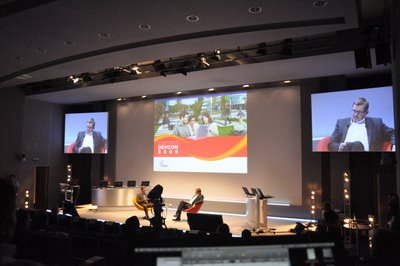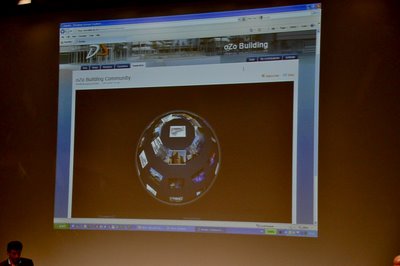
#1: Apologies for the tardiness in posting this, the video took way too long to process and even then, doesn’t really give the right look. But anyway, on with the show:
Well, it’s a bright, brisk morning in Velizy, located in the southwest of Paris and the first thing we’re doing it donning a wicked pair of 3D stereographic glasses for a virtual tour of Dassault Systemes impressive new campus (where you can buy a heart attack inducing strong cup of coffee for a bargain .50 euro). The DS campus is split into four interconnected buildings, named Air, Water, Fire and Earth are the names for the four buildings that make up the – and as the campus uses 3 times less electricity and emits 6 times less CO2 compared to the average office block.
Taking the stage first is Domnique Florack, who heads up research and development at Dassault Systemes. Three major achievements since the last DEVCON are the last 18 months, won 4,000 new Enovia customers (including Gucci and Samsung Semiconductor). Second key fact is relating to SolidWorks and its achievement of reaching 1,000,000 user licenses and the final one is (amazing considering) 3dvia.com has more than 600,000 users connected using content relating to 3dvia related communities. Incidently there’s just been an annoucement regarding the availability of high-end content for 3dvia as well – details here.
When asked about the three key events that have happened in the last 12 months, Florack picked up the acquisition of Engenious enable “Lifecycle Simulation” capabilities in Simulia, a new partnership with Intercim and its tools for PLM driven manufacturing execution and business process engineering to work with Delmia to develop the next generation tools manufacturing related set of tools. Finally Florack highlighted the creation of the DS Design Studio, lead by industry veteran Anne Asensio) which is aiming to help companies with their design processes.
Announcements for this morning are: the announcement of V6R2010, highlights including 42 new products (modules), a new solution for the mid-market PLM Express Version 6 (which we’ll try to get more details about) and “revolutionary modelling and simulation technologies” tools for “innovation collaboration and social engineering.”
Demonstrated this morning was the new platform for Social Innovation (iPLM), a hosted service for managing a company’s development based processes by allowing a much richer set of tools that are in line with the current thinking in social networking, but with 3D at its centre, enhanced with the usual range of web 2.0 tools for tagging, status updating, access management, group subscription and threaded discussion.
Communities can be open or closed. Setting up new community projects is pretty much a case of selecting users and assigning priorities and access levels (Author, commentator), adding the required media, whether in the form of documents, text, images, video or 3D data.
The Innovation Sphere – a slick little way to navigate content hosted on the iPLM service.
Much of this information can be viewed using the ‘innovation sphere’, which presents all of this information in a odd looking but seemingly highly navigable spherical manner, so you can browse through your assets with ease. There also seems to be a wealth of analytics data, which allows the project manager to view information about how your community is reacting to content (which from a design perspective is highly value and almost impossible to gauge using currently available tools).
Here we’ve got some quickly shot video of what was demonstrated next and to say that this is impressive technology for connecting a community centred around product development and use of 3D data is a massive understatement. While some parts aren’t shown in the video, there’s been a complete demonstration of how the company is using Cloud-based computing to offer additional services alongside interconnected design and collaboration tools, from Live Experts (which are real people, available 24/7 to assist with learning all manner of things covering the full range of DS offerings), photo realistic rendering.
What’s interesting about what Dassault have is how its connected with its tools currently available. By using a platform that actually follows many of the clues given by generally application web 2.0 technologies and services, but readapting them to the process of product development and execution, Dassault are doing something quite different from many other vendors jumping on the social networking bandwagon – in that they seem to ‘get’ what its all about. Allowing users and communities to connect using web-based technology, then offer them tools that back that up. One of the most interesting thing shown is how you can create a project, then provide the tools that are required to fulfil that project – whether that’s lightweight modelling technologies in the form of LiveShape or more industrial strength tools like Catia, Delmia and yes, Solidworks. For several years, Dassault have been discussing delivering its technologies across the web – and we’re finally starting to see that enabled and delivered upon.
Note: Dassault also unveiled an 3d iPhone app that let’s you access content from 3Dvia and do some funky things with the phone’s camera. I’ll post about that later today, maybe early tomorrow.







